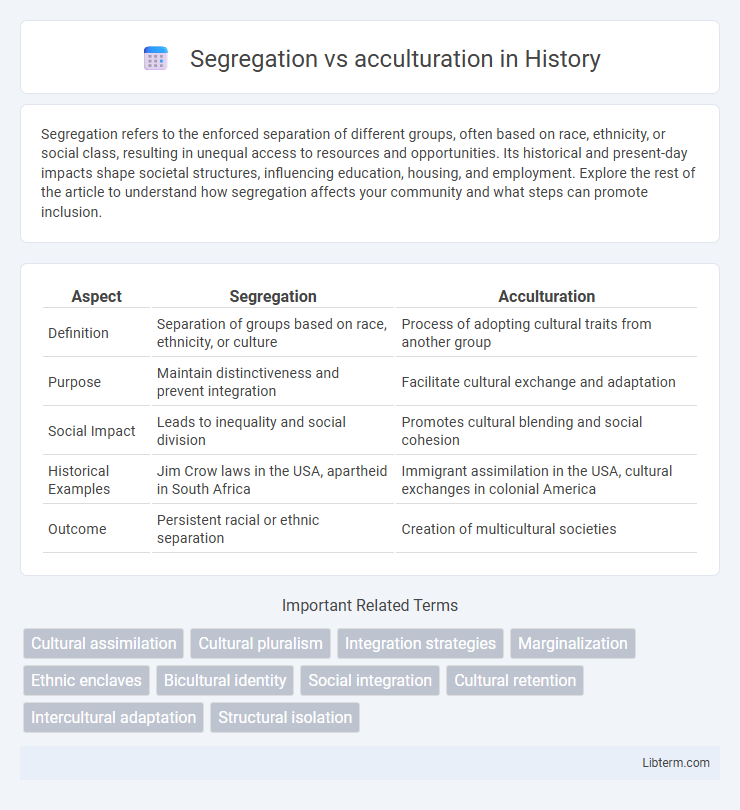Segregation refers to the enforced separation of different groups, often based on race, ethnicity, or social class, resulting in unequal access to resources and opportunities. Its historical and present-day impacts shape societal structures, influencing education, housing, and employment. Explore the rest of the article to understand how segregation affects your community and what steps can promote inclusion.
Table of Comparison
| Aspect | Segregation | Acculturation |
|---|---|---|
| Definition | Separation of groups based on race, ethnicity, or culture | Process of adopting cultural traits from another group |
| Purpose | Maintain distinctiveness and prevent integration | Facilitate cultural exchange and adaptation |
| Social Impact | Leads to inequality and social division | Promotes cultural blending and social cohesion |
| Historical Examples | Jim Crow laws in the USA, apartheid in South Africa | Immigrant assimilation in the USA, cultural exchanges in colonial America |
| Outcome | Persistent racial or ethnic separation | Creation of multicultural societies |
Understanding Segregation and Acculturation
Segregation involves the separation of cultural or ethnic groups, limiting interaction and integration with the broader society, often leading to social isolation and unequal access to resources. Acculturation describes the process through which individuals or groups adopt aspects of another culture while maintaining elements of their original identity, facilitating social cohesion and cultural exchange. Understanding these concepts is essential for addressing multicultural dynamics and promoting inclusive policies in diverse communities.
Historical Perspectives on Cultural Integration
Historical perspectives on cultural integration reveal segregation as a method used to maintain social hierarchies and control, often resulting in systemic exclusion of minority groups from economic and political participation. Acculturation represents the adaptive process whereby marginalized communities adopt elements of the dominant culture while preserving distinct cultural identities, facilitating selective cultural exchange and hybridization. Studies on immigration and colonialism highlight how these processes have shaped societal structures, influencing policies on multiculturalism and social cohesion in various historical contexts.
Key Differences Between Segregation and Acculturation
Segregation involves the physical or social separation of groups based on cultural, racial, or ethnic differences, often resulting in limited interaction and preservation of distinct identities. Acculturation refers to the process through which individuals or groups adopt elements of another culture while maintaining aspects of their original culture, leading to cultural exchange and adaptation. The key difference lies in segregation emphasizing separation and isolation, whereas acculturation promotes integration and mutual cultural influence.
Social Impacts of Segregation
Segregation creates profound social divides by limiting interaction between different cultural or ethnic groups, which fosters misunderstanding, prejudice, and social tension. This separation often leads to unequal access to resources, opportunities, and services, perpetuating systemic inequalities and social stratification. The lack of cross-cultural integration hinders community cohesion, social mobility, and inclusive growth, affecting overall societal stability.
Benefits and Challenges of Acculturation
Acculturation offers benefits such as enhanced cultural understanding, improved social integration, and economic opportunities by enabling individuals to adapt to a dominant culture while retaining aspects of their heritage. Challenges include potential identity conflicts, language barriers, and the risk of cultural dilution or loss of traditional values. Navigating these complexities requires balancing cultural preservation with openness to new cultural norms to foster social cohesion and personal well-being.
Psychological Effects on Individuals and Communities
Segregation often leads to increased psychological stress, feelings of isolation, and diminished self-esteem among individuals, while communities may experience reduced social cohesion and limited resource access. Acculturation presents psychological challenges such as identity confusion and cultural stress but can enhance adaptability and social integration over time. Both processes significantly impact mental health outcomes, with segregated groups facing higher risks of anxiety and depression, whereas successful acculturation promotes resilience and cross-cultural understanding.
Segregation vs Acculturation in Education Systems
Segregation in education systems restricts access to resources and opportunities by isolating students based on race, ethnicity, or language, leading to unequal academic outcomes and social divisions. Acculturation promotes the integration of diverse cultural backgrounds within schools, fostering inclusivity and enhancing cross-cultural understanding while supporting bilingual education and culturally responsive teaching. Research indicates that acculturation strategies improve student engagement and academic achievement by creating an environment that values diversity and encourages cultural exchange.
Policy Approaches: Inclusion or Separation?
Segregation as a policy approach enforces separation by limiting minority groups' interaction with the dominant culture, often resulting in social exclusion and unequal access to resources. Acculturation promotes inclusion by encouraging minority groups to adopt aspects of the dominant culture while maintaining their own cultural identities, fostering integration and mutual understanding. Policymakers face the challenge of balancing cultural preservation with social cohesion, influencing whether societies prioritize separation or inclusion in their multicultural strategies.
Case Studies: Global Examples of Segregation and Acculturation
Case studies reveal that segregation persists in cities like Johannesburg, where apartheid-era policies have entrenched spatial division, limiting economic mobility for black South Africans. In contrast, Singapore exemplifies successful acculturation, blending diverse ethnic groups through government-implemented multicultural policies and integrated housing, fostering social cohesion. These examples highlight how policy frameworks and historical contexts crucially influence the outcomes of segregation and acculturation worldwide.
Promoting Social Harmony Through Cultural Integration
Segregation often leads to social fragmentation and limited intercultural understanding, while acculturation fosters mutual respect and cooperation by encouraging cultural exchange and adaptation. Promoting social harmony relies on integrating diverse cultural practices, enabling communities to build shared values and collective identities. Effective cultural integration policies support inclusive environments where diversity strengthens social cohesion and reduces conflict.
Segregation Infographic

 libterm.com
libterm.com